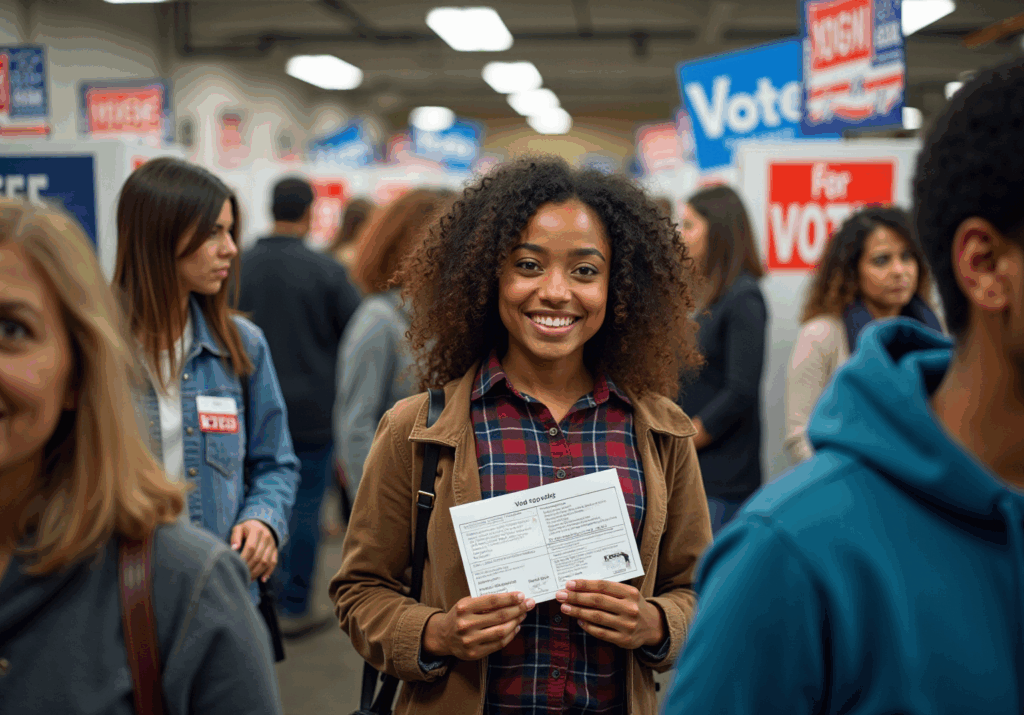Overview
The article delivers essential insights into the proportion of eligible citizens who participate in voting, emphasizing voter turnout as a critical indicator of civic engagement and the overall health of democracy. It underscores that various factors, including demographics, significant historical legislation such as the Voting Rights Act, and innovative voting solutions, play a pivotal role in influencing participation rates. Furthermore, this highlights the urgent need for inclusive strategies aimed at enhancing electoral engagement among underrepresented groups. By addressing these elements, the article calls for a concerted effort to improve voter turnout, ultimately strengthening democratic processes.
Introduction
Voter turnout serves as a vital indicator of civic engagement, reflecting the active participation of eligible citizens in the democratic process. The 2024 presidential election showcased a turnout of approximately 65.3%. This statistic carries implications that extend far beyond mere numbers; it highlights the health of democracy and the representation of diverse interests.
However, what factors contribute to these turnout rates? How do historical and contemporary challenges shape the voting landscape? Understanding these dynamics is essential for fostering a more inclusive electoral process and ensuring that every voice is heard in shaping the future of governance.
Define Voter Turnout: Proportion of Eligible Adult Citizens Who Vote
Voter turnout is defined as the proportion of eligible adult citizens who actually vote in a given election, which reflects the percentage of those who participate in polls by casting their votes. The metric that compares the number of votes cast to the total count of eligible participants is referred to as the proportion of eligible adult citizens who actually vote in a given election. In the 2024 presidential election, approximately 65.3% of the voting-eligible population participated, indicating a notable level of civic engagement. This figure is crucial as it reflects the health of democracy, influencing policy decisions and the representation of diverse interests in government.
Increased electoral turnout is frequently linked to a stronger democratic process, as it promotes wider engagement and accountability among elected representatives. Votem offers innovative online voting solutions that enhance accessibility for all qualified voters, including military personnel and individuals with disabilities. As noted by Linda McCulloch, implementing Votem’s system was her greatest accomplishment in office. Furthermore, Votem effectively handled the collection of 299,000 votes for the National Radio Hall of Fame, a significant rise from the prior year, demonstrating how efficient voting solutions can enhance engagement.
Additionally, the New Mexico State Republican Party expressed satisfaction with Votem’s software performance, indicating a commitment to using their services for future elections. Comprehending voter engagement not only emphasizes the significance of involvement but also stresses the necessity for approaches that tackle obstacles to voting, guaranteeing that all voices are acknowledged in the democratic process.
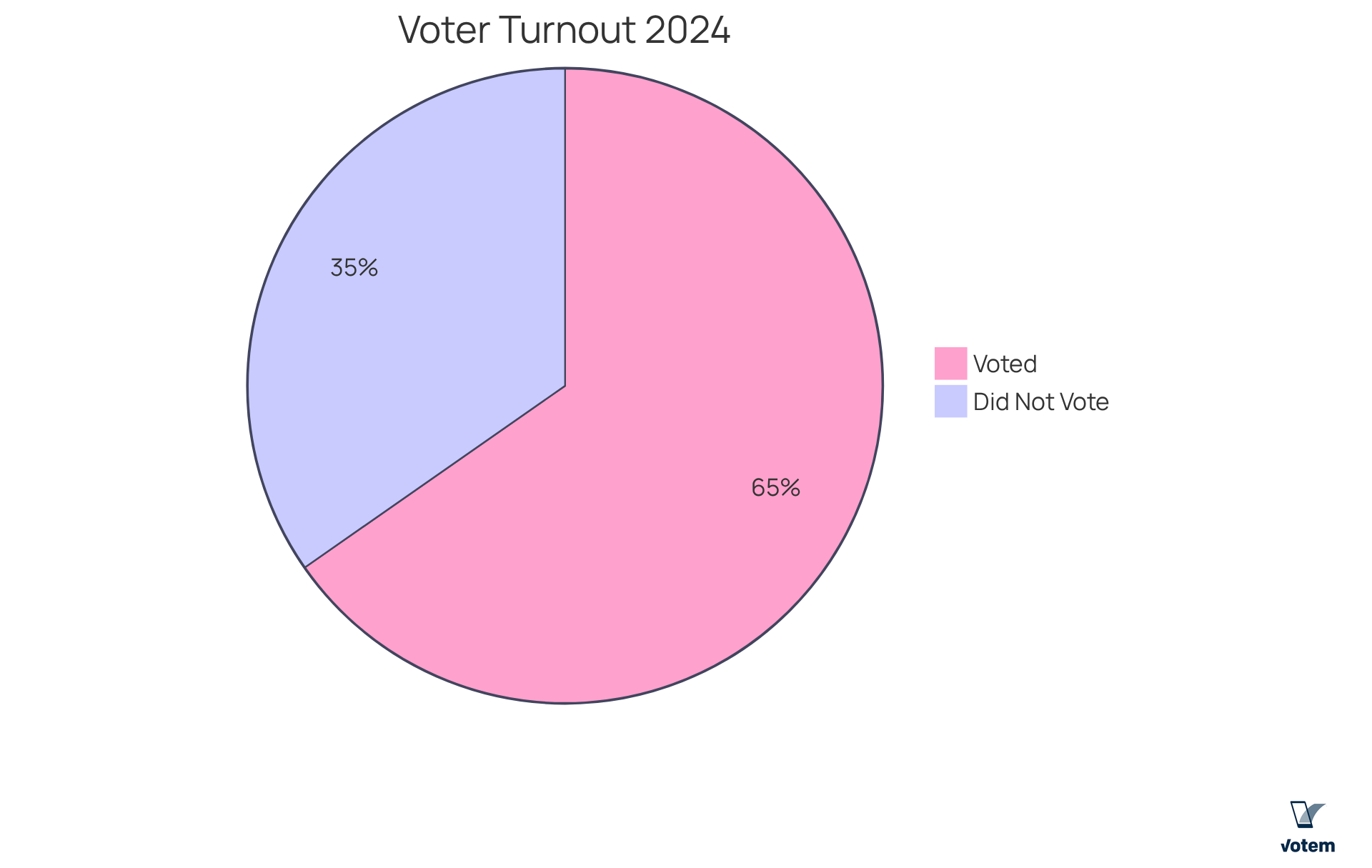
Examine Historical Trends in Voter Turnout and Voting Rights
Voter participation in the United States has historically undergone significant fluctuations, influenced by various social and political movements. The Voting Rights Act of 1965 marked a transformative moment in this landscape, aiming to dismantle barriers that prevented African Americans from voting. This legislation resulted in a notable rise in engagement among marginalized groups, particularly in areas formerly defined by discriminatory practices. Research indicates that regions with larger Black populations experienced substantial increases in electoral registration and participation following the Act’s passage. For instance, from 1960 to 1980, the elimination of literacy tests led to a marked rise in Black electoral engagement, while concurrent initiatives to rally White citizens constrained the overall impact of the Act in narrowing the Black-White divide in political involvement.
In recent years, innovative solutions like those provided by Votem have emerged to further enhance accessibility and participation in elections. Votem’s contemporary online voting system has significantly improved accessibility for all eligible participants, including military personnel and individuals with disabilities. This commitment to inclusivity is underscored by testimonials from satisfied clients, such as the New Mexico State Republican Party, which praised Votem’s software for its effectiveness and reliability. Furthermore, Votem successfully managed the collection of 299,000 votes for the National Radio Hall of Fame, showcasing a significant rise in participant engagement compared to prior years.
Turnout rates have consistently fluctuated, and the proportion of eligible adult citizens who actually vote in a given election is known as typically being greater in presidential contests than in midterm contests. Recent data from the 2024 election suggests a resurgence in public engagement, reflecting heightened awareness and mobilization regarding electoral rights and responsibilities. This trend underscores the ongoing significance of the Voting Rights Act in promoting an inclusive democratic process, as it remains a vital framework for ensuring fair access to the ballot box, supported by contemporary solutions that enhance participation.
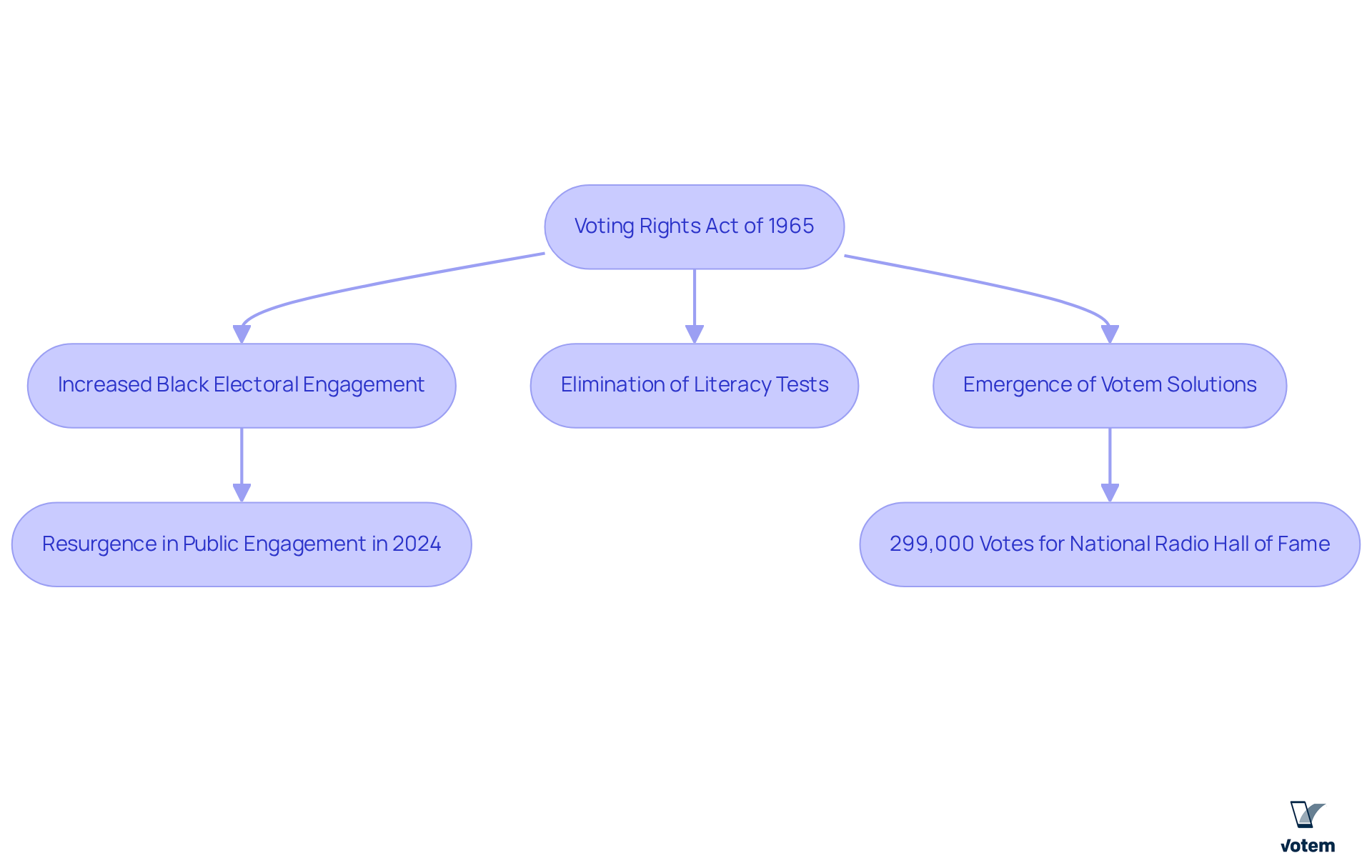
Analyze Factors Influencing Voter Turnout: Demographics and Beyond
Voter participation is significantly influenced by a multitude of factors, particularly demographics such as age, race, and socioeconomic status. Studies consistently demonstrate that older participants engage at notably higher rates compared to their younger counterparts. For instance, in the 2024 elections, youth electoral engagement was approximately 47%, reflecting a slight decrease from 50% in 2020, while older age demographics exhibited substantially greater involvement rates. Racial and ethnic minorities often face systemic barriers that impede their electoral engagement, with young Black men voting at only 25% and young Latino men at 27%. These barriers include restricted access to voting resources, socioeconomic challenges, and historical disenfranchisement, which collectively hinder participation among these groups.
Education level and income also play critical roles in electoral participation. States that have adopted facilitative measures, such as automatic registration and simplified voting processes, have witnessed significant increases in participation. For example, Minnesota, which implemented automatic voter registration and allowed 16-year-olds to preregister, achieved the highest youth participation rate at 62% in 2024. Conversely, states like Oklahoma and Arkansas, lacking such supportive laws, reported some of the lowest youth turnout rates at 33% each.
Understanding these dynamics is essential for developing effective strategies aimed at enhancing what is known as the proportion of eligible adult citizens who actually vote in a given election among underrepresented groups. Votem’s innovative online voting solutions, particularly the CastIron platform, enhance accessibility and security, enabling individuals to participate in elections from anywhere, whether at home or while traveling. As noted by Linda McCulloch, “Implementing Votem’s new, modern system which allowed greater access for all eligible participants from military individuals to those with disabilities was my greatest accomplishment in office.” This capability is crucial in addressing the barriers faced by younger voters and racial minorities. Furthermore, Votem successfully managed the receipt of 299,000 votes on behalf of the National Radio Hall of Fame, an increase from last year’s 126,000 votes received, demonstrating the effectiveness of their solutions. By promoting educational initiatives that enhance civic engagement and leveraging technology to simplify the voting process, organizations can work towards a more inclusive electoral process. Additionally, it is noteworthy that 94% of youth indicated that democracy influenced their voting decisions, reflecting the motivations behind their electoral participation.
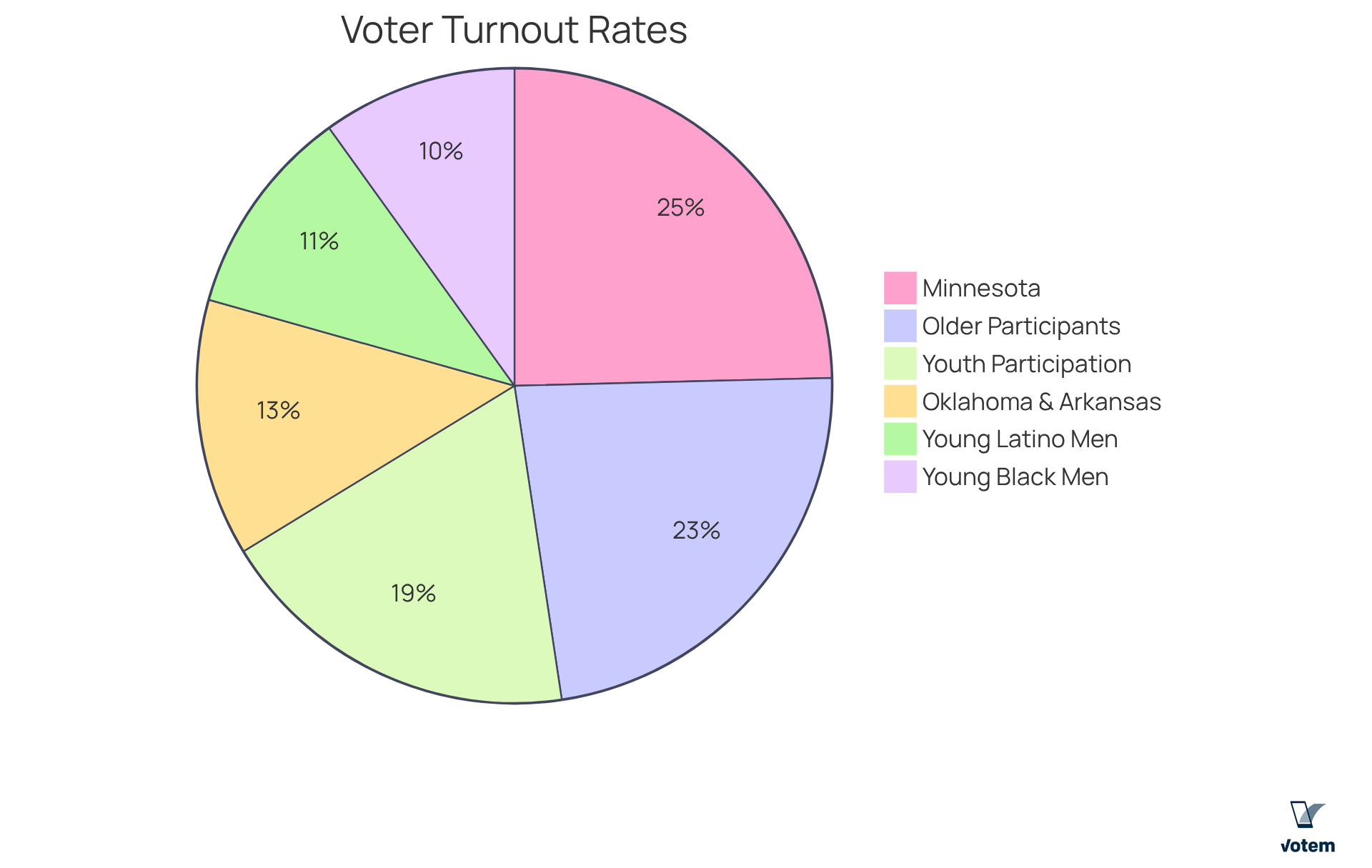
Discuss the Importance of Voter Turnout for Democracy and Representation
Voter participation stands as a cornerstone of democracy, wielding significant influence over the legitimacy of elected officials and the policies they enact. High participation rates correlate with a broader representation of diverse viewpoints within government, fostering more equitable policy outcomes. For instance, the 2020 presidential vote witnessed an impressive participation rate of 66%, the highest since 1904. This remarkable figure indicates a more involved electorate and a government that more accurately reflects public opinion. Conversely, low participation can distort representation, as evidenced by the 27% turnout in Philadelphia’s 2019 mayoral vote, raising concerns about disenfranchisement and citizen apathy. Such a disconnect can lead to policies misaligned with the broader community’s needs, particularly in local elections where turnout often lags behind federal elections.
Engaging citizens through targeted outreach and innovative strategies is essential for cultivating a vibrant democracy where every voice is acknowledged and valued. Experts emphasize that boosting citizen participation not only enhances democratic vitality but also diminishes the likelihood of electing officials who do not represent the electorate’s interests. Therefore, fostering voter engagement is crucial for ensuring that government actions resonate with the will of the people, ultimately fortifying the democratic process.
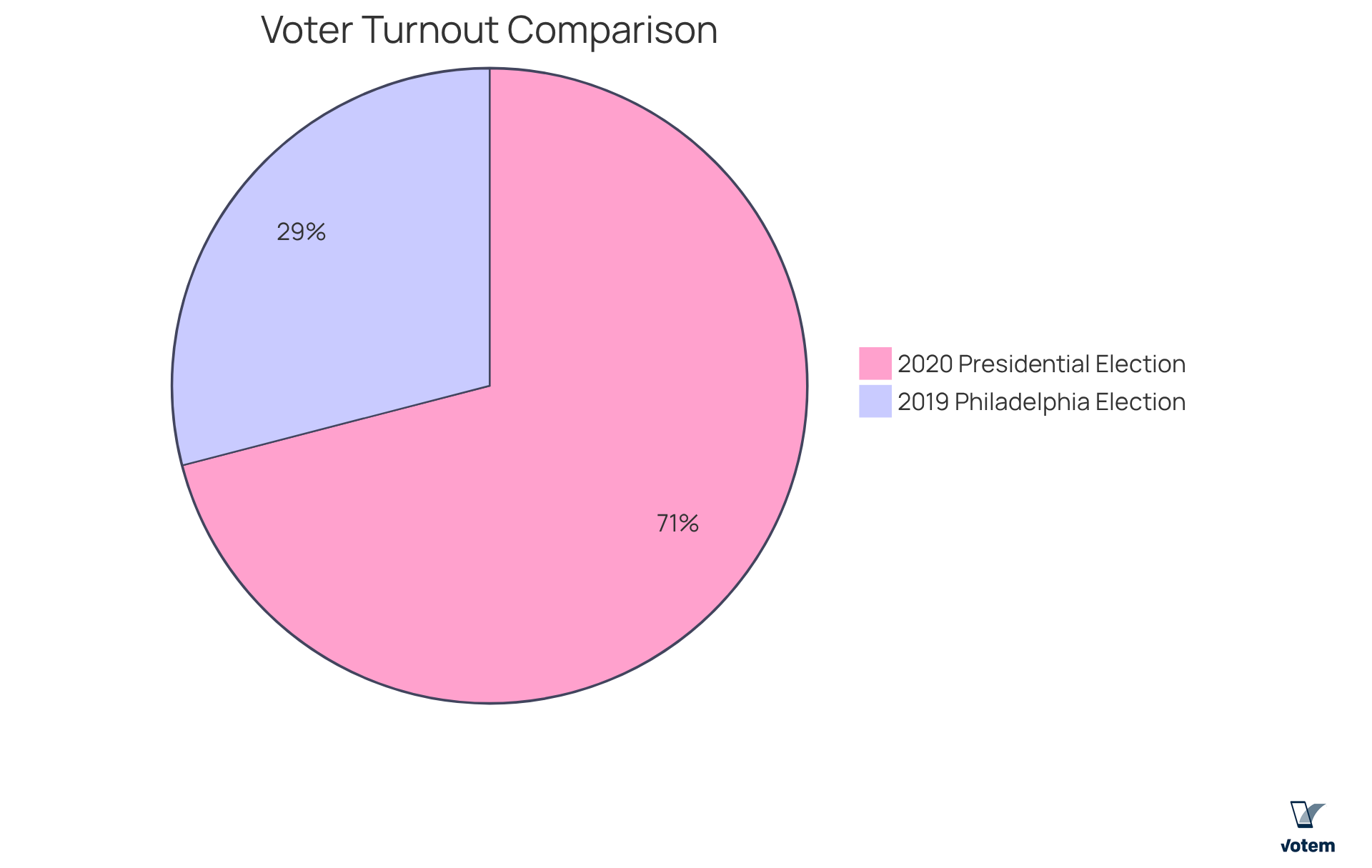
Conclusion
Voter turnout serves as a critical measure of democratic health, reflecting the engagement of eligible citizens in the electoral process. Understanding voter turnout transcends mere statistics; it is a vital component that shapes representation and policy outcomes. By examining historical trends, demographic influences, and innovative solutions for enhancing accessibility, we recognize that fostering higher participation rates is essential for a truly representative democracy.
Key insights reveal that voter turnout is influenced by various factors, including age, race, and socioeconomic status. Historical milestones, such as the Voting Rights Act of 1965, have significantly increased participation among marginalized groups. Furthermore, contemporary solutions like Votem’s online voting platforms continue to enhance accessibility. The data from recent elections underscores the necessity of addressing barriers that prevent segments of the population from exercising their right to vote, thereby ensuring that every voice is heard in the democratic process.
Ultimately, the significance of voter turnout extends beyond mere numbers; it is about empowering citizens and ensuring that their interests are represented in government. Engaging in targeted outreach and leveraging technology can help break down barriers to participation. As the landscape of voting continues to evolve, it is crucial for all stakeholders to prioritize efforts that promote a more inclusive and vibrant democracy, where every eligible citizen has the opportunity to make their voice count.
Frequently Asked Questions
What is voter turnout?
Voter turnout is defined as the proportion of eligible adult citizens who actually vote in a given election, reflecting the percentage of those who participate in polls by casting their votes.
What was the voter turnout in the 2024 presidential election?
Approximately 65.3% of the voting-eligible population participated in the 2024 presidential election, indicating a notable level of civic engagement.
Why is voter turnout important?
Voter turnout is crucial as it reflects the health of democracy, influences policy decisions, and represents diverse interests in government.
How does increased electoral turnout affect democracy?
Increased electoral turnout is linked to a stronger democratic process, promoting wider engagement and accountability among elected representatives.
What solutions does Votem offer to enhance voting accessibility?
Votem offers innovative online voting solutions that enhance accessibility for all qualified voters, including military personnel and individuals with disabilities.
What recognition did Linda McCulloch give to Votem’s system?
Linda McCulloch noted that implementing Votem’s system was her greatest accomplishment in office.
How did Votem perform in collecting votes for the National Radio Hall of Fame?
Votem effectively handled the collection of 299,000 votes for the National Radio Hall of Fame, demonstrating a significant rise from the prior year.
What feedback did the New Mexico State Republican Party provide about Votem?
The New Mexico State Republican Party expressed satisfaction with Votem’s software performance and indicated a commitment to using their services for future elections.
What is the significance of understanding voter engagement?
Understanding voter engagement emphasizes the importance of involvement and stresses the necessity for approaches that tackle obstacles to voting, ensuring that all voices are acknowledged in the democratic process.
List of Sources
- Define Voter Turnout: Proportion of Eligible Adult Citizens Who Vote
- 2024 Presidential Election Voting and Registration Tables Now Available (https://census.gov/newsroom/press-releases/2025/2024-presidential-election-voting-registration-tables.html)
- How many Americans voted in 2024? | USAFacts (https://usafacts.org/articles/how-many-americans-voted-in-2024)
- Voter turnout | MIT Election Lab (https://electionlab.mit.edu/research/voter-turnout)
- Voter Turnout – FairVote (https://fairvote.org/resources/voter-turnout)
- Examine Historical Trends in Voter Turnout and Voting Rights
- Jesuit Resource – Election Day Quotes (https://xavier.edu/jesuitresource/online-resources/quote-archive1/election-dayvoting)
- Voting rights equal economic progress: The Voting Rights Act and U.S. economic inequality (https://equitablegrowth.org/voting-rights-equal-economic-progress-the-voting-rights-act-and-u-s-economic-inequality)
- US Elections Project – Voter Turnout Data (https://electproject.org/election-data/voter-turnout-data)
- Sixty years of the Voting Rights Act: progress and pitfalls (https://academic.oup.com/oxrep/article/40/3/486/7907277)
- Analyze Factors Influencing Voter Turnout: Demographics and Beyond
- Growing Racial Disparities in Voter Turnout, 2008–2022 (https://brennancenter.org/our-work/research-reports/growing-racial-disparities-voter-turnout-2008-2022)
- New Data: Nearly Half of Youth Voted in 2024 (https://circle.tufts.edu/latest-research/new-data-nearly-half-youth-voted-2024)
- The Youth Vote in 2024 (https://circle.tufts.edu/2024-election)
- Number of Voters as a Share of the Voter Population, by Age | KFF State Health Facts (https://kff.org/state-health-policy-data/state-indicator/number-of-individuals-who-voted-in-thousands-and-individuals-who-voted-as-a-share-of-the-voter-population-by-age)
- US Elections Project – Voter Turnout Demographics (https://electproject.org/election-data/voter-turnout-demographics)
- Discuss the Importance of Voter Turnout for Democracy and Representation
- These Inspiring Quotes Will Get You Excited to Vote (https://countryliving.com/life/g24446791/voting-quotes)
- MMA Case Study Hub | How the Biden Campaign Gamified Democracy and Achieved a Record-Breaking CTR (https://mmaglobal.com/case-study-hub/case_studies/view/70842)
- Voter turnout | MIT Election Lab (https://electionlab.mit.edu/research/voter-turnout)
- Voter Turnout – FairVote (https://fairvote.org/resources/voter-turnout)

